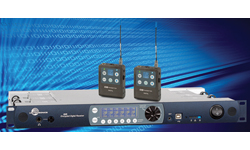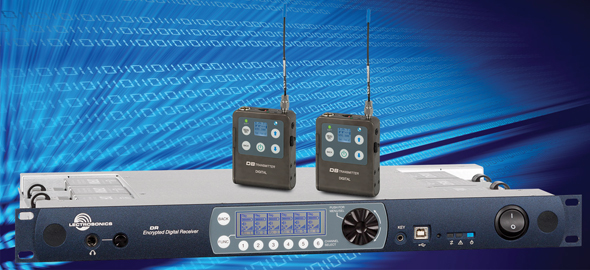
Lectrosonics has introduced the Digital Secure Wireless system, outfitted with AES-256-CTR (Advanced Encryption Standard) encryption technology for use in environments where privacy is of paramount concern, such as corporate boardrooms, shareholder meetings, and government facilities.
As a rugged and high-quality system, it is also well-suited for touring, performing arts, film making and other demanding applications.
AES (Advanced Encryption Standard) encryption technology employing a 256-bit key was approved as a government standard encryption algorithm in 2001 [FIPS 197]. The CTR (Counter) Encryption mode as found in the new Lectrosonics Digital Secure Wireless system maintains low latency (2.5 ms overall) while keeping channel noise at a minimum.
Key management is user selectable in one of two modes: “persistent,” where the key is kept from session to session, and “one-time,” where the key must be generated for each session (most secure). The system utilizes a special chip for entropy generation in order to ensure the key is generated in a truly random manner, thus complying with another government standard [FIPS 140-2]. The key transfer requires a simple cabled download, avoiding security issues with easily detected infrared key transfer systems.
The new system consists of the DR digital wireless receiver frame, the individual DRM digital receiver modules, and the DB digital wireless beltpack transmitter. Similar in form to Lectrosonics Venue receiver systems, the DR digital wireless receiver frame supports up to 6 channels/modules in 1RU.
Analog and digital (AES/EBU) XLR outputs are selectable on the device menu. The frame supports wideband reception (470.100 to 691.175 MHz), 50 Ohm BNC antenna inputs, and outputs for cascading up to 3 additional frames (24 channels total) on one set of antennas, without an external multi-coupler.
The clock input and output enables the DR to be the master clock in a digital audio system or to be the slave to an external master clock. A 1/4-inch headphone output can be fed from a mixture of channel signals, or from isolated channels.
The DRM digital receiver module docks into the DR digital wireless receiver frame and up to six modules can be docked per a single DR frame. Each receiver module has a 25.5 MHz bandwidth. The new DRM digital receiver modules are available on all standard Lectrosonics frequency blocks.
The Lectrosonics DB digital wireless beltpack transmitter offers wideband tuning (470-698 MHz), a highly linear RF output stage for reduced intermodulation distortion and for this reason, high channel counts are possible even with minimum RF spectrum available. The transmitter provides true 50 mW transmission RF power for excellent range and resistance to dropouts. The TA5M mic/line input found on the DB digital wireless beltpack transmitter accepts all lavalier and headworn microphones wired for Lectrosonics transmitters.
Karl Winkler, director of business development at Lectrosonics, states, “The new Digital Secure Wireless system is the ideal tool for those environments where privacy is crucial and is, for example, particularly well-suited for use at large corporations, banks and other financial institutions. With the passage in 2002 of the Sarbanes-Oxley Act, information security and access control have been central themes with companies in compliance with the law. Closed sets, theater and live productions can similarly benefit from secure wireless mic transmission. Our new Digital Secure Wireless system provides the convenience of wireless freedom while protecting one’s sensitive information.”
Specifications for the new system:
Audio frequency response—20 Hz to 20 kHz +/- 1dB
Digital conversion—24 bits, 48 kHz sampling
System latency—2.5 ms
Distortion—.05% THD+N, 1 kHz @ -10 dBFS
Dynamic range—108 dB A-wtd.
The new Lectrosonics Digital Secure Wireless system is slated to become available Q3, 2014. Pricing has not yet been determined.

